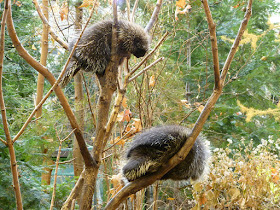Not too long ago on one of our early morning dog walks (in the dark with headlamps and reflective gear this time of year) we came across a porcupine. We were walking along and suddenly my dog lunged toward something on the side of the road that then began to slide down the banking backwards towards us. Quickly recognizing the black and white warning coloration and having come across these large rodents on walks before, I pulled the dog back before any harm was done to either party involved. Luckily, porcupines are not the most fast-moving or graceful creatures!
Although a face-full of quills can be very dangerous for pets and other would-be predators, porcupines are by far one of my favorite animals. You probably have not heard many people say that, but there are probably not too many people who have had the same experiences I have had with them.
When I graduated college I got a summer internship at Squam Lakes Natural Science Center. The center educates about wildlife and has a non-releasable wildlife collection that serve as ambassadors for their species at schools, camps, after school programs, etc. That summer and the following two years as I was hired to continue working as an assistant naturalist I shared the porcupine with many audiences.
Why do I love the porcupine so much?
Incredible Adaptations: Although the porcupine has a poor sense of sight, they make up for it with excellent hearing and smell. Their most fabulous adaptation is their specialized hair. They have up to 30,000 barbed quills used for protection. One question I've been asked over and over is how far they can shoot their quills, well first of all THEY DO NOT SHOOT THEIR QUILLS!! They can raise and lower their quills just as your dog or cat may raise its fur when agitated. By lashing their tail back and forth and moving towards another animal, the quills easily dislodge from the porcupine and into the other creature. The porcupine has no mechanism for shooting quills out of its skin. The quills are barbed on one end, making them very difficult to remove. If you or a pet ever were to be quilled it is crucial to remove the quills as quickly as possible as the contraction of muscles pulls them deeper inside.
 |
| Porcupine Quills Vary from Species and Individual (image by lamiot from [Public domain], via Wikimedia Commons) |
Quills are not the only type of porcupine hair. There are bristly hairs on the tail that help the porcupine keep its balance while up in trees and warm fuzzy underfur to keep the porcupine warm. They also have long guard hairs that help them to know their surroundings, just like a cat's whiskers.
Vocalizations: Porcupines make a variety of sounds for communication. Although it is easy to anthropomorphize because some of their sounds resemble human words, we cannot tell what they are saying. However, it is endearing, and that is probably why Teddy Bear the porcupine from Zooniversity has become so popular. Keep in mind that porcupines in the wild are not eating pumpkins and corn on the cob like Teddy. In their natural habitat they browse on hemlock twigs, and eat an herbivore diet of leaves, bark and soft plants like skunk cabbage and clover.
Baby porcupines: A baby porcupine is called a porcupette! They are born with soft quills that harden within hours of being born. The porcupine only has one baby at a time, and the young porcupette will stay with its mom for about 6 months after it is born.
There are so many other fascinating facts about porcupines. Did you know that they are the second largest mammal in North America? (Do you know what the largest is?) Porcupines have also gone by other names historically, like quill-pig and similarly Stachelschwein, which means "thorn-swine" in German. For a thorough summary of the porcupine, visit Animal Diversity Web's page on the animal.
 |
| A pair of porcupines in a tree. (image by: Mattnad (Own work) [CC BY-SA 3.0 or GFDL], via Wikimedia Commons) |
More fun ways to teach and learn about porcupines! (These are affiliate links, see disclosures for more details.)
Folkmanis makes excellent, realistic puppets that are great for teaching young children about animals. Check out their porcupine here.
What better way to explore porcupine quills than examining them up close? With guidance students can explore these specialized hairs under a magnifier or microscope. Purchase them here.


No comments:
Post a Comment